AMD Ryzen Threadripper 3970X vs Intel Core i9-10980XE: High End Flagships Fight

If you just so happen to be in the market for some serious firepower, both AMD and Intel have new high-powered HEDT (high-end desktop) processors designed for the heaviest workloads. Intel recently launched its Cascade Lake-X family, spanning from ten to 18 cores, while AMD unleashed the third-generation Ryzen Threadripper chips with models that come with either 24 or 32 cores.
The 32-core 64-thread Ryzen Threadripper 3970X is the current flagship for AMD's Ryzen Threadripper lineup, although that will change soon when the chipmaker rolls out the 64-core Ryzen Threadripper 3990X next year. On the other side of the ring, we have the 10th-generation Core i9-10980XE, which serves as the flagship for Team Intel with 18 cores and 36 threads.
Unfortunately, the comparison between the two flagships is rather lopsided: Intel has ceded the upper tiers of the HEDT market to AMD and doesn't have a comparable chip based on core counts or pricing. However, this is a battle of the most powerful consumer silicon from both companies.
To help you pick one, we put the flagship models from both chipmakers through a seven-round face-off, based on their features, overclocking, coolers, motherboards, performance, and value.
Features
The AMD Ryzen Threadripper 3970X comes packing AMD's potent Zen 2 microarchitecture and is produced with TSMC's 7nm FinFET manufacturing process. The core-heavy Ryzen Threadripper 3970X comes equipped with 32 cores and 64 threads that operate with a 3.7 GHz base clock and a 4.5 GHz boost clock. AMD feeds the cores with up to 144MB of total cache (128MB L3 cache).
The Ryzen Threadripper 3970X supports up to four DDR4-3200 memory channels, ECC (error-correcting code) memory, and can accommodate up to 256GB of DDR4 memory. The chip also exploits the latest PCIe 4.0 interface, providing up to 64 PCIe 4.0 lanes for high-speed storage and compatible graphics cards.
| Header Cell - Column 0 | Intel Core i9-10980XE | AMD Ryzen Threadripper 3970X |
|---|---|---|
| Architecture | Cascade Lake | Zen 2 |
| Socket | LGA2066 | sTRX4 |
| Cores / Threads | 18 / 36 | 32 / 64 |
| Base Frequency (GHz) | 3.0 | 3.7 |
| Boost Frequency (GHz) | 4.8 | 4.5 |
| L3 Cache | 24.75MB | 128MB |
| Process | 14nm | 7nm |
| TDP | 165W | 280W |
| Memory Speed | DDR4-2933 | DDR4-3200 |
| Memory Controller | Quad-Channel | Quad-Channel |
| Integrated Graphics | N/A | N/A |
| Recommended Customer Pricing | $979 - $1,000 | $1,999 |
The Intel Core i9-10980XE is based on Intel's new Cascade Lake microarchitecture and ultra-mature 14nm process node. It comes with 18 cores, 36 threads, and 24.75MB of L3 cache. The processor clocks in with a 3.0 GHz base and 4.8 GHz boost.
Get Tom's Hardware's best news and in-depth reviews, straight to your inbox.
Like the Ryzen Threadripper 3970X, the Core i9-10980XE has a quad-channel memory controller and supports up to 256GB of DDR4 capacity. However, Intel sets official memory support at DDR4-2933, and the chip doesn't support the ECC standard. Not to mention that the Core i9-10980XE is still on the PCIe 3.0 interface and only provides the user with up to 48 PCIe 3.0 lanes.
Winner: AMD. The Ryzen Threadripper 3970X possesses a superior feature set. For starters, the core-heavy processor sports useful features, such as PCIe 4.0 and ECC memory support. Additionally, the Ryzen Threadripper 3970X also offers more cores, cache, and speedy PCIe 4.0 lanes, all of which can make a significant difference in the HEDT market.
Motherboard Options
Unlike consumer-class motherboards, there is no chipset segmentation in the HEDT market: One chipset from each vendor delivers all the features the processors have to offer. That would be the X299 chipset for the Core i9-10980XE, and the TRX40 chipset for the Ryzen Threadripper 3970X.
One caveat with the Ryzen Threadripper 3970X is that it resides on a new sTRX4 socket, locking out existing X399 motherboard owners from upgrading to the new chips. Like the processor itself, a TRX40 motherboard consumes a hefty chunk of your budget. The entry-level models typically start around $400, while high-end models stretch up to as much as $850.
The Core i9-10980XE, on the other hand, continues to slot into existing X299 motherboards with the LGA2066 socket. This means that as long as your motherboard is running the proper BIOS, you can just drop the 18-core part into your motherboard without spending a penny on another motherboard.
Nevertheless, motherboard manufacturers have released a fresh wave of revised X299 motherboards to accommodate the Core i9-10980XE. That's because the new Cascade Lake-X chips come with four additional PCIe 3.0 lanes, which you can't access on an older motherboard. In regards to pricing, X299 and revised X299 motherboards start at $160 and $260, respectively. The premium offerings top out at around $750.
Winner: Tie. Upgrading to the Core i9-10980XE is cheaper because you're not forced to invest in a new motherboard. If you're starting from scratch, there are more X299 options out there to choose from. A quick search dug up as many as 62 different X299 motherboards out in the wild as opposed to the 12 TRX40 models that are currently available.
On the flipside, we suspect that X299 is probably a dead end platform, meaning it won't be compatible with next-gen chips, while TRX40 is barely in diapers. From a future-proof perspective, TRX40 motherboards represent a better long-term investment even though they are more expensive right now.
Overclocking Potential
The Ryzen Threadripper 3970X and Core i9-10980XE come with unlocked multipliers, opening the doors to manual overclocking. Overclocking aficionados will be happy to know that both processors use solder thermal interface material (sTIM), which improves thermal dissipation, and thus overclocking potential.
Since both processors are relatively new, there aren't many statistics on their overclocking potential. For now, we'll evaluate each chip in accordance with our experience.
Although AMD advertises the Ryzen Threadripper 3970X with a 4.5 GHz boost clock, our chip only hit that speed on a single core, and it depends on several factors. We prefer to let AMD's auto-overclocking Precision Boost Overdrive (PBO) feature do its thing so we continue to benefit from the single-core boost while also enjoying higher clocks in multi-threaded workloads.
AMD's Ryzen 3000-series consumer processors are a bit stingy on manual overclocking headroom. We expect the new Ryzen Threadrippers to inherit the trait as well. The ceiling for the Ryzen Threadripper 3970X is likely around 4.1 GHz to 4.3 GHz — that is assuming you're blessed with a good sample and own the necessary custom liquid cooling system to tame the processor.
The Core i9-10980XE features a single-core boost of 4.8 GHz. However, we got our sample to a whopping 4.8 GHz on all cores with a 1.2V Vcore and 2.1V VCCIN. That's pretty amazing considering we only got the previous-gen Core i9-9980XE to 4.4 GHz, but as always, the silicon lottery applies. You'll also need a beefy custom watercooling loop to extract the utmost performance.
Winner: Intel. The Core i9-10980XE might be at a core disadvantage, but the 18-core part holds tremendous overclocking potential.
Cooling Solutions
The Ryzen Threadripper 3970X and Core i9-10980XE are multi-core monsters that can't be tamed with your typical CPU air cooler, therefore, neither AMD or Intel includes a stock cooler with the processor.
The Ryzen Threadripper 3970X is rated with a 280W TDP (thermal design power), meaning you'll need a very beefy cooler to keep the temperatures in check. AMD recommends you pair the Ryzen Threadripper 3970X with a capable liquid cooling solution. Thankfully, the cooler mounting mechanism for the sTRX4 socket is identical to the previous-gen TR4 socket. That means you can repurpose your existing Threadripper cooler for the 3970X, assuming it's up to the task.
The Core i9-10980XE rocks a 165W TDP, which is 115W lower than the Ryzen Threadripper 3970X. It's important to remember that TDP ratings don't correlate directly to power consumption, but as expected, the 10980XE's lower overall power consumption equates to lower thermal output. Intel's chips also have a better efficiency rating in AVX workloads, but Threadripper does hold the absolute performance crown.
Winner: Intel. The Core i9-10980XE has a substantially lower peak power consumption rating. As a result, there are more cooling options available and, if you aren't overclocking, you don't have to spend as much on cooling as you would with AMD's 32-core beast. However, it is noteworthy that AMD's chips come with far more cores and take the absolute performance lead in threaded workloads, so the tradeoff of increased thermal output is acceptable.
Gaming Performance








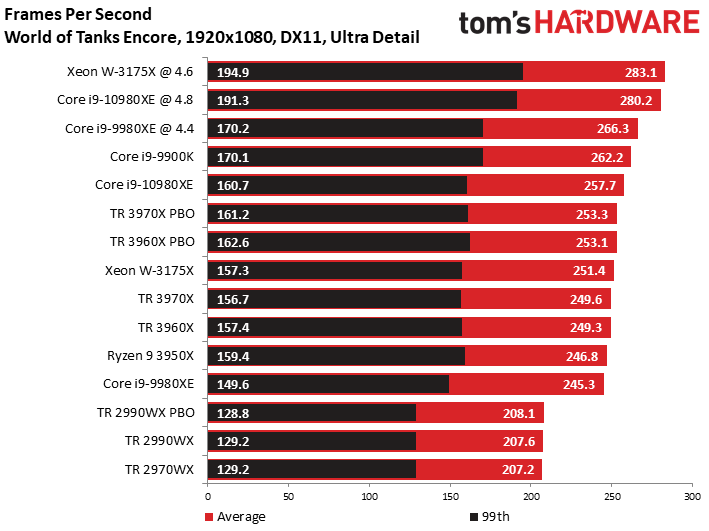




The chances of anyone picking up a Ryzen Threadripper 3970X or Core i9-10980XE solely for gaming purposes are very slim. However, streamers will surely appreciate the abundance of cores. Besides, even professional users need to relax every once in a while.
In general, the Ryzen Threadripper 3970X is a better gaming processor than the Core i9-10980XE. AMD's 32-core part delivers up to three more average frames per second in five out of nine titles. The Core i9-10980XE only beat the Ryzen Threadripper 3970X in three titles, with differences up to eight frames per second.
Winner: AMD. The Ryzen Threadripper 3970X might not be a gaming monster, but it's still marginally faster than the Core i9-10980XE. If you plan to do a fair bit of gaming, the Ryzen Threadripper 3970X has your back.
Productivity Performance











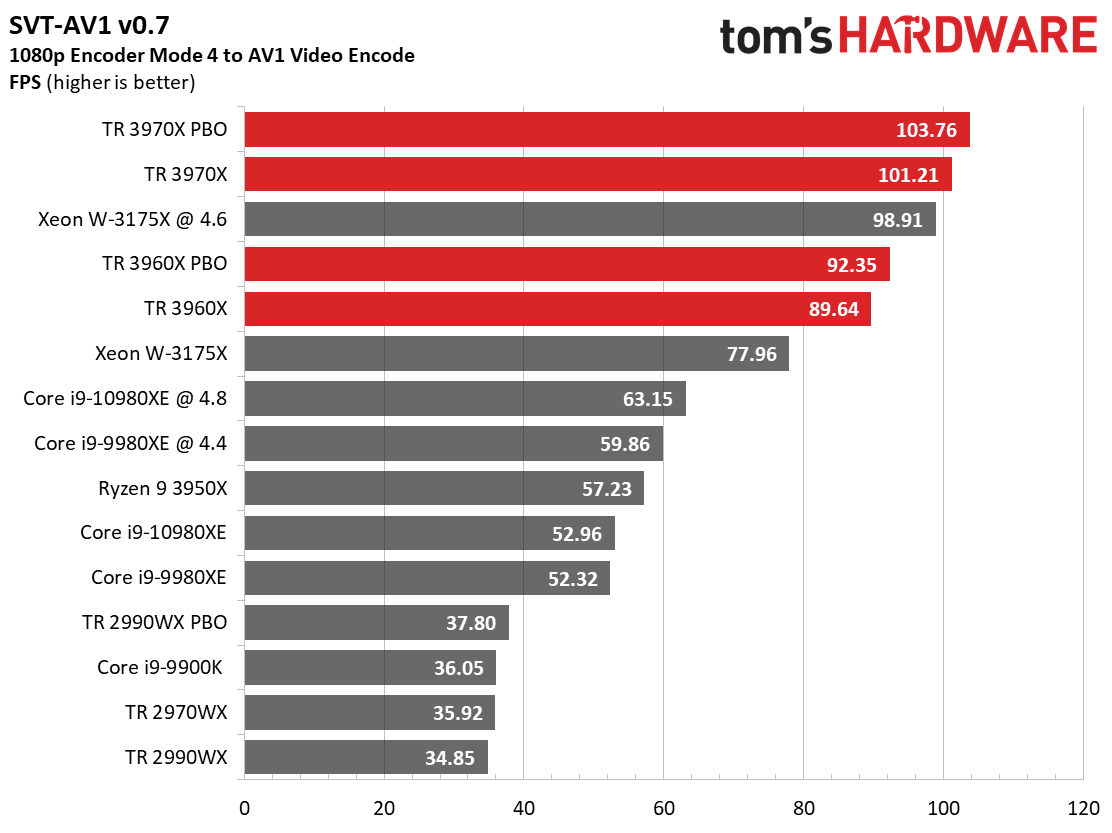



















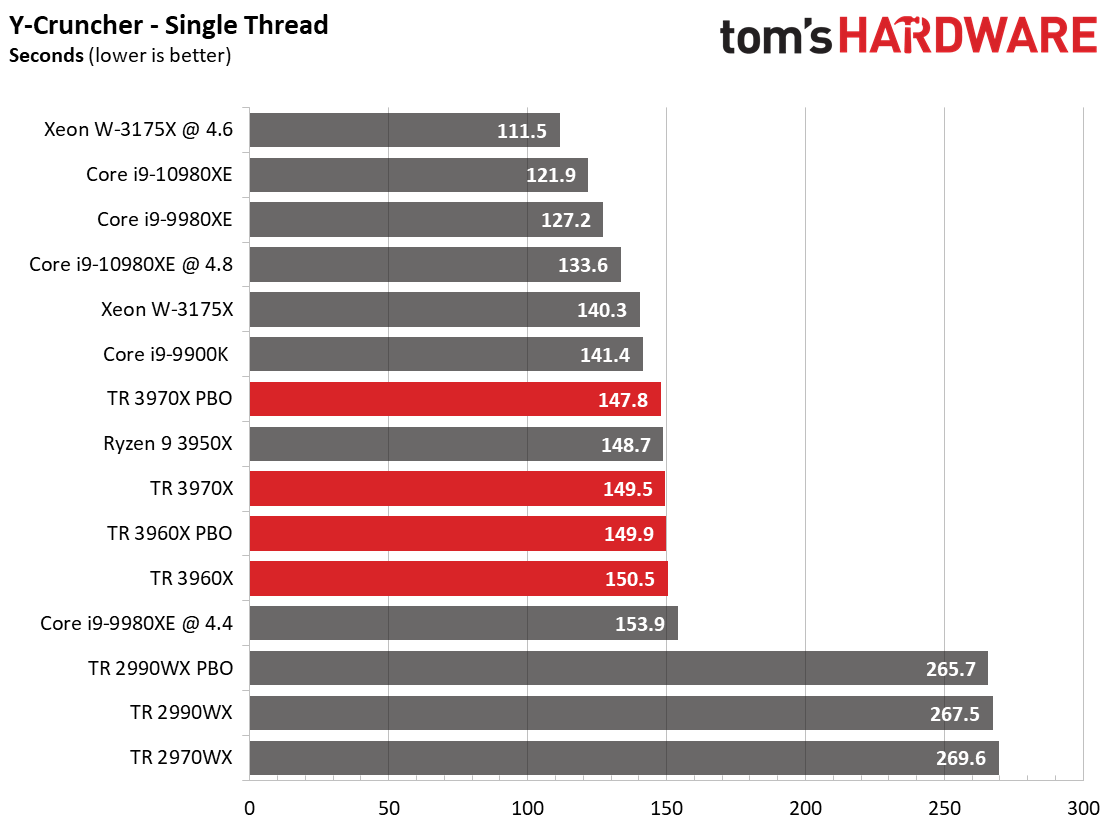



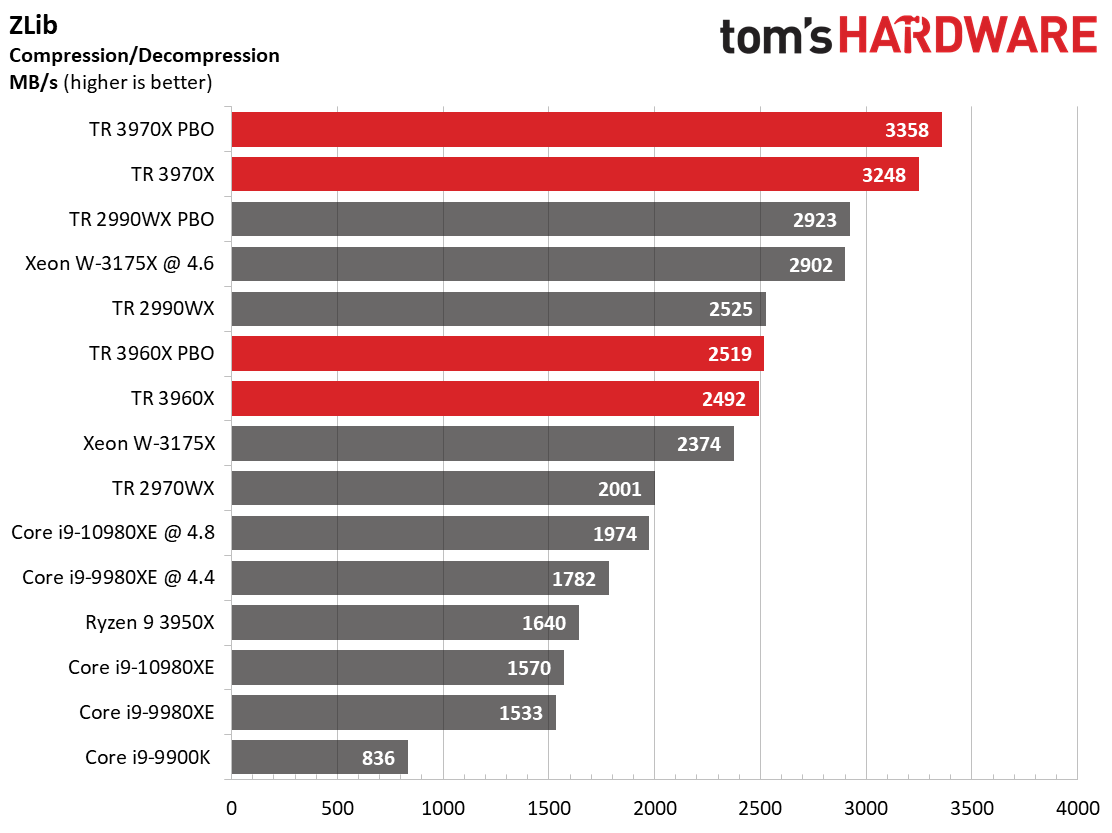


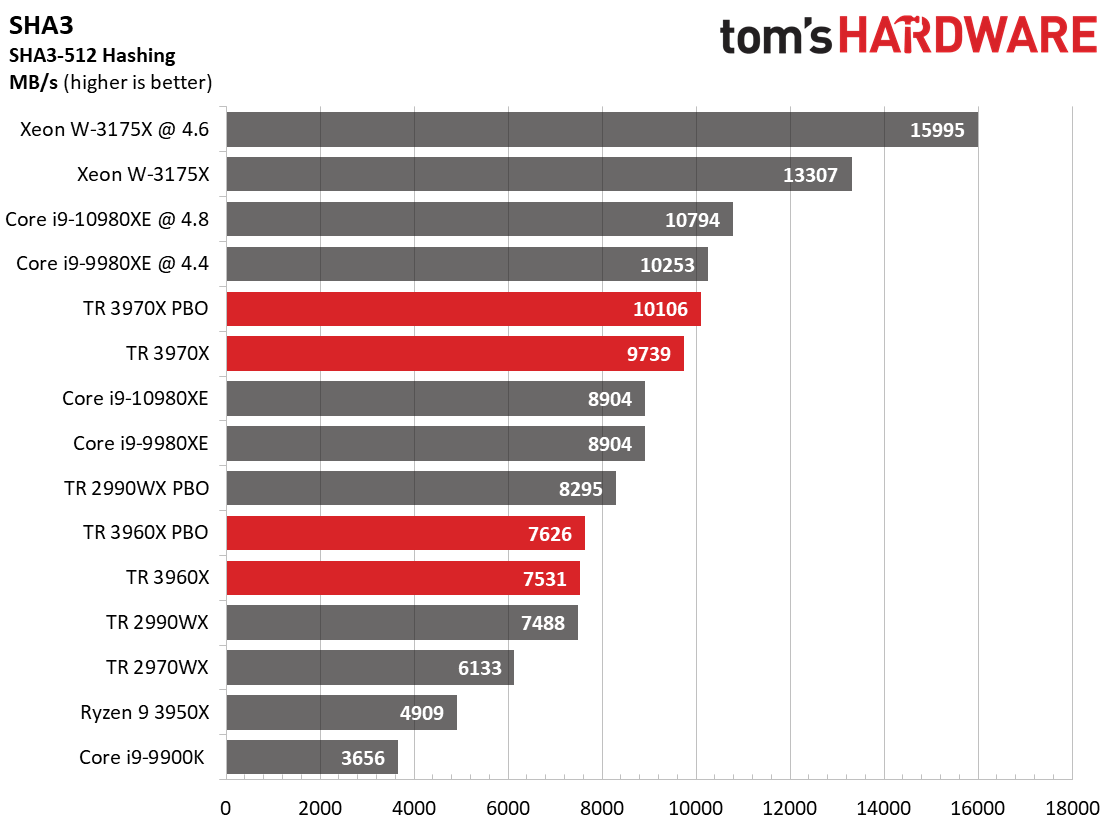

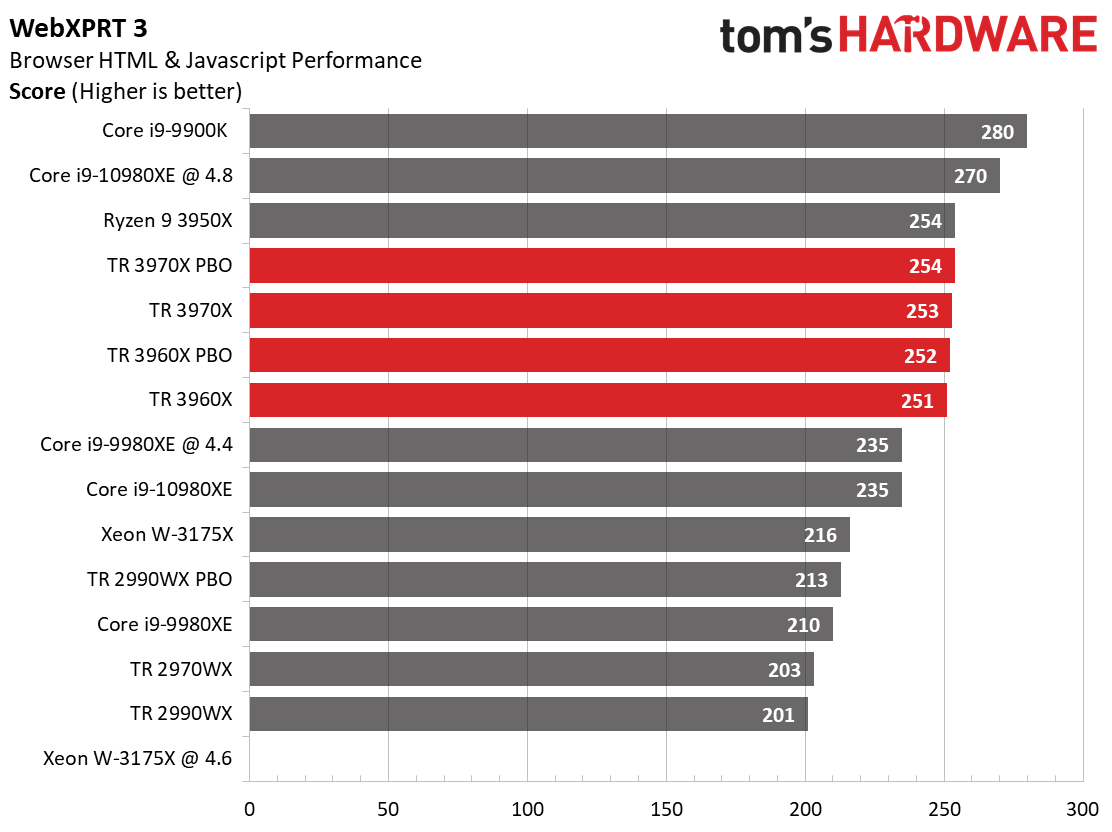


The Ryzen Threadripper 3970X and Core i9-10980XE really excel with productivity workloads. Judging by the specifications alone, it's easy to see why the AMD chip should come out as the winner: The Ryzen Threadripper 3970X has 14 more cores than the Core i9-10980XE.

The Ryzen Threadripper 3970X outperforms the Core i9-10980XE in both workstation and Adobe benchmarks. We continue to see the Ryzen Threadripper 3970X's dominance in rendering, encoding, compression and general office workloads. The Core i9-10980XE beats the Ryzen Threadripper 3970X in a couple of benchmarks.
Winner: AMD, without a doubt. If you're looking for a processor specifically for work, the Ryzen Threadripper 3970X is the way to go.
Value Proposition
| Header Cell - Column 0 | SEP (USD) | Cores / Threads | TDP (Watts) | Base / Boost Frequency (GHz) | L3 Cache (MB) | PCIe 4.0 Lanes |
|---|---|---|---|---|---|---|
| Threadripper 3990X | ? | 64 / 128 | 280W | ? | 256 | ? |
| Threadripper 3970X | $1,999 | 32 / 64 | 280W | 3.7 / 4.5 | 128 | 64 |
| Threadripper 3960X | $1,399 | 24 / 48 | 280W | 3.8 / 4.5 | 128 | 64 |
| Threadripper 2990WX | ~$1,700 | 32 / 64 | 250W | 3.0 / 4.2 | 64 | 64 Gen3 |
| Threadripper 2970WX | ~$925 | 24 / 48 | 180W | 3.5 / 4.4 | 64 | 64 Gen3 |
| Ryzen 9 3950X | $749 | 16 / 32 | 105W | 3.5 / 4.7 | 64 | 64 |
| Ryzen 9 3900X | $499 | 12 / 24 | 105W | 3.8 / 4.6 | 64 | 24 |
The Ryzen Threadripper 3970X has a $1,999 price tag while the Core i9-10980XE should cost $1,000. Essentially, you're paying $62.47 per core on the AMD chip and $55.56 on the Intel. Neither HEDT processor is in stock at the moment, though.
Factoring in the cost of a TRX40 motherboard and a liquid cooling solution if you don't already own one, you might need to spend another $600 at the very least if you're rolling with the Ryzen Threadripper 3970X.
In the Core i9-10980XE's case, you could walk away with $350 for a X299 motherboard and a cooler that can handle 165W if you're going the budget route. But then again, you'll be buying a platform that already has one foot in the retirement home.
Winner: Tie. The Ryzen Threadripper 3970X clearly requires a more hefty investment, but you also get way more performance out of the chip. Strong competition has forced Intel's hand to reconsider the pricing on its products. Presently, the X299 platform is as cheap as an HEDT platform can get.
The Bottom Line
Some might argue that it's not fair to compare the Ryzen Threadripper 3970X to the Core i9-10980XE given the huge core difference, but this is a battle of the flagships, after all. Sadly, Intel has been stagnant in the HEDT space, and its flagship part stops at 18 cores. It just so happens that AMD doesn't currently have a 18-core chip to go head-to-head with the Core i9-10980XE. So, for the time being, it is what it is.
The Ryzen Threadripper 3970X outshines the Core i9-10980XE in both productivity and gaming workloads. It's hard to not give AMD the win in a market where performance is the main concern. Performance is expensive, but so is cutting-edge technology like PCIe 4.0, which we think is worth the additional cost.
One of the main advantages of picking up a HEDT platform is that you know you won't have to replace it every year. Fortunately, AMD has the upper hand since the chipmaker just introduced the sTRX40 socket. There is no promise that AMD will commit to the sTRX40 socket, but if it's anything like the original TR4 socket, it should last for a couple of good years.
Overall Winner: AMD
| Round | Intel Core i9-10980XE | AMD Ryzen Threadripper 3970X |
|---|---|---|
| Features | Row 0 - Cell 1 | ✗ |
| Motherboard Options | ✗ | ✗ |
| Overclocking Potential | ✗ | Row 2 - Cell 2 |
| Cooling Solutions | ✗ | Row 3 - Cell 2 |
| Gaming | Row 4 - Cell 1 | ✗ |
| Productivity Performance | Row 5 - Cell 1 | ✗ |
| Value Proposition | ✗ | ✗ |
| Total | 4 | 5 |
MORE: AMD Ryzen Threadripper 2 vs. Intel Skylake-X: Battle of the High-End CPUs
MORE: AMD Ryzen 2 vs. Intel Coffee Lake: What's the Best CPU Platform?
MORE: CPU Hierarchy - A Comparison of AMD and Intel Processors

Zhiye Liu is a news editor, memory reviewer, and SSD tester at Tom’s Hardware. Although he loves everything that’s hardware, he has a soft spot for CPUs, GPUs, and RAM.
-
gfg I think it would be better to show the two processors alone and their overclock. In several games intel wins AMD clearly after overcloking and the conculusion does not accompany that.Reply -
jortego128 I think it would be better to show OC results on a separate page altogether, much like its done over @guru3d. Including baseline and overclocks for the same chip in the same test just convolutes the graphs and makes it more cluttered than it needs to be. Most people arent going to buy a workstation CPU and OC to get a few more fps in games.Reply -
jdlech I'm starting to think there's a market for a chip that has decent multi thread performance, but has one specific processor with outstanding turbo boost... and a way to assign a demanding thread to that one processor.Reply
It's OK that all the processors only go up to 4GHz. But what some programs really need is that one processor to crank it all the way up to 6GHz, even when all the surrounding processors slow down to compensate for the heat generation.
Because there's a lot of apps outside of FPS games that still rely on one single thread.
(looking at you, Stellaris). -
Phaaze88 Reply
The majority of people of whom these processors are marketed towards aren't going to overclock them. They(overclockers) are the minority of PC owners.gfg said:I think it would be better to show the two processors alone and their overclock. In several games intel wins AMD clearly after overcloking and the conculusion does not accompany that.
Same deal for their use in a gaming PC. Only a handful of content creators would go that route, of which they'd all be well served with a 3900X/3950X/9900K + 2080Ti.
It's nice to see the OC potential of these chips, but it's not very important here.
I agree that they should've been separated. It made the results a little confusing to look at, honestly.jortego128 said:I think it would be better to show OC results on a separate page altogether, much like its done over @guru3d. Including baseline and overclocks for the same chip in the same test just convolutes the graphs and makes it more cluttered than it needs to be. Most people arent going to buy a workstation CPU and OC to get a few more fps in games.
Out of the box performance is key in this market. -
mdd1963 Alienware undoubtedly has some Mega Gaming $7K rig planned with one of these CPUs in it, never mind that it will be outperformed by something costing $3-$4k less...Reply -
joeblowsmynose Replygfg said:I think it would be better to show the two processors alone and their overclock. In several games intel wins AMD clearly after overcloking and the conculusion does not accompany that.
Considering that no CPU with more than 16 cores was ever designed as a gaming product, and that ANY person that needs 18 or 32 cores, isn't needing a 5% advantage in FPS, and isn't bottle-necking their CPU to game, perhaps the gaming results are irrelevant here.
Or perhaps there should be weighting of the values - for example, on HEDT CPUs, more weight to productivity scores at stock clocks, less weight to overclocking and less weight to gaming.
Where on say a 9700k / 3700x - less weight on productivity applications and more on gaming and overclocking.
That would be sensible.
But at the end of the day these TH "comparisons" are all a little tongue-in-cheek from my perspective -- don't take them so seriously. -
ceomrman2 When comparing products head to head, it seems logical to roughly match either performance or price. The AMD is double the price of the Intel, plus its supporting cast is almost double, too. An entry-level workstation based on the Threadripper would cost almost twice as much as one based on the Intel. It would be much more capable, too. It's like comparing entry level cars with a Hyundai Accent and BMW 2-series. You'd have to drop all the way to a TR 2950X to get the CPU+MB price within 10%. That's a very different discussion. At this time, the Intel seems pretty logically priced in the marketplace. It's performance is clearly inferior to the latest TR chips, but that's why it's half the price.Reply -
dave.jeffers There really isn't a comparison between the Threadrippers and the Core i9-10980XE. This is why most reviewers chose to compare the i9 to the 3950X. Much closer performance, with the 3950X being much better value.Reply -
Phaaze88 Reply
Do you realize you're denying the fact that both Threadripper and the 10980XE are marketed as HEDT parts?dave.jeffers said:There really isn't a comparison between the Threadrippers and the Core i9-10980XE.
Intel marketed the cpu as an HEDT part, therefore it gets evaluated as one. Threadripper is too, so there IS a comparison to be made between them.
The gaming results are just the bland side salad.
3950X isn't a HEDT part. It's a mainstream one, albeit very expensive. It doesn't have the extra PCIE lanes or expandability of HEDT.dave.jeffers said:This is why most reviewers chose to compare the i9 to the 3950X. Much closer performance, with the 3950X being much better value.
It is, and should be rather embarrassing for Intel when a mainstream part outperforms their HEDT one in professional workloads...
"You had one job... ONE JOB..."